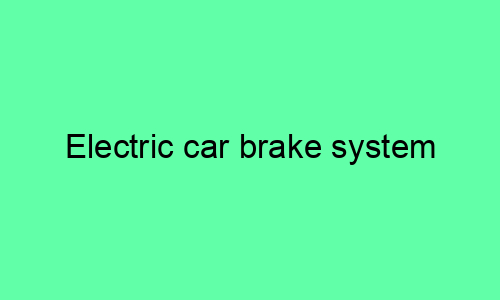Electric Car Brake System
Introduction
Electric cars are becoming increasingly popular, and with good reason. They’re more efficient than gasoline-powered cars, they produce zero emissions, and they’re often much quieter. However, one area where electric cars have traditionally lagged behind gasoline-powered cars is in braking performance.
Gasoline-powered cars use a hydraulic brake system, which relies on the force of brake fluid to apply pressure to the brake pads. This system is very effective, but it can be expensive to maintain and repair. Electric cars, on the other hand, use a regenerative braking system, which uses the electric motor to slow the car down. This system is less expensive to maintain and repair, but it can be less effective than a hydraulic brake system.
How Regenerative Braking Works
Regenerative braking works by converting the kinetic energy of the moving car into electrical energy. This electrical energy is then stored in the car’s battery, where it can be used to power the electric motor or other electrical components.
When you apply the brakes in an electric car, the electric motor switches from being a motor to a generator. This generator then slows the car down by creating resistance to the wheels. The faster the car is moving, the more resistance the generator creates, and the more quickly the car slows down.
Regenerative braking is most effective at low speeds. At high speeds, the kinetic energy of the moving car is too great for the electric motor to absorb. In these situations, the car’s hydraulic brakes will also be applied to help slow the car down.
Advantages of Regenerative Braking
Regenerative braking has several advantages over hydraulic braking. First, it is more efficient. When you apply the brakes in a gasoline-powered car, some of the kinetic energy of the moving car is lost as heat. In an electric car, however, the kinetic energy is converted into electrical energy, which can be stored in the car’s battery. This means that electric cars can travel further on a single charge than gasoline-powered cars.
Second, regenerative braking is less expensive to maintain and repair. Hydraulic brake systems require regular maintenance, such as brake pad replacements and fluid changes. Regenerative braking systems, on the other hand, do not require any maintenance. This can save you money in the long run.
Third, regenerative braking is more environmentally friendly. Hydraulic brake systems produce brake dust, which can contain harmful pollutants. Regenerative braking systems, on the other hand, do not produce any brake dust.
Disadvantages of Regenerative Braking
Regenerative braking also has some disadvantages. First, it can be less effective than hydraulic braking. This is especially true at high speeds. In these situations, the car’s hydraulic brakes will also be applied to help slow the car down.
Second, regenerative braking can cause the car to jerk when you first apply the brakes. This is because the electric motor is suddenly switching from being a motor to a generator. However, this jerking can be minimized by using a brake pedal that is specifically designed for regenerative braking.
Conclusion
Regenerative braking is a promising technology that has the potential to improve the efficiency, cost, and environmental friendliness of electric cars. However, it is important to be aware of the limitations of regenerative braking before you decide if it is right for you.






